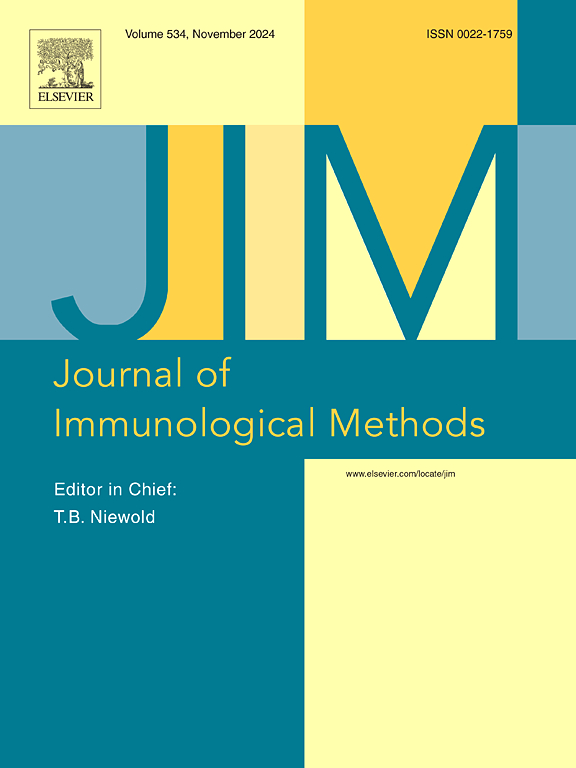Validation for soluble C5b-9 detection and comparative analysis of three quantification methods
IF 1.6
4区 医学
Q4 BIOCHEMICAL RESEARCH METHODS
引用次数: 0
Abstract
Background
Soluble C5b-9 (sC5b-9) is a biomarker of complement activation, representing the soluble form of the Terminal Complement Complex (TCC), which is released into circulation rather than embedding in the cell membrane. Measurement of sC5b-9 is increasingly utilized for detecting complement activation, particularly in conditions like thrombotic microangiopathy and during complement inhibitor therapy. Accurate detection of sC5b-9 can be useful for guiding therapeutic decisions, especially in patients receiving anti-C5 inhibitors. This study aimed to validate the Quidel sC5b-9 ELISA kit and compare its performance with two other assays, Hycult and SVAR, focusing on assay linearity and therapeutic monitoring.
Methods
The analytical performance of the Quidel sC5b-9 ELISA kit was evaluated using 60 split samples over a wide concentration range, in collaboration with a peer laboratory. Precision, sensitivity, linearity, and reference limits were assessed, mainly using artificially activated samples with magnesium chloride and Zymosan, covering a broad range of sC5b-9 concentrations. Four patient samples with complement-mediated diseases were also tested. The correlation between the Quidel, Hycult, and SVAR assays was analyzed with 40 samples, while linear ranges were compared using 11 proportionally diluted samples. Additionally, the impact of anti-C5 inhibitors on sC5b-9 concentrations was evaluated by spiking anti-C5 biosimilar drugs into activated plasma.
Results
The Quidel sC5b-9 assay showed accuracy, with an R2 of 0.90 and a qualitative concordance of 93.3 %. Very few discrepancies were noted in samples near the reference limit. Both intra- and inter-assay precision were below 20% CV for samples above the Limit of Quantification (LOQ) of 170 ng/mL. Linearity studies defined the reportable range for Quidel's assay as 220–1800 ng/mL. Comparisons among Quidel, SVAR, and Hycult assays revealed strong correlations, with the Hycult kit demonstrating a broader linear range, maintaining linearity even at concentrations 10 times higher than its highest calibrator. All assays showed a significant reduction in sC5b-9 concentrations after the addition of 50 μg/mL of Eculizumab biosimilar, with SVAR and Quidel reaching values close to their lowest calibrators. In contrast, the Hycult assay maintained a wide dynamic range even at 100 μg/mL of anti-C5 inhibitor addition.
Conclusions
This study confirms that the Quidel sC5b-9 ELISA kit is a reliable tool for detecting complement activation and inhibition. However, the Hycult assay offers a broader dynamic range which can be an important consideration when assessing assay suitability for for disease monitoring and therapeutic assessments.
可溶性C5b-9的检测验证及三种定量方法的比较分析
可溶性C5b-9 (sC5b-9)是补体活化的生物标志物,代表末端补体复合物(TCC)的可溶性形式,它被释放到循环中而不是嵌入细胞膜。sC5b-9的测量越来越多地用于检测补体激活,特别是在血栓性微血管病和补体抑制剂治疗期间。准确检测sC5b-9可用于指导治疗决策,特别是在接受抗c5抑制剂治疗的患者中。本研究旨在验证Quidel sC5b-9 ELISA试剂盒,并将其与其他两种检测方法Hycult和SVAR的性能进行比较,重点关注检测线性和治疗监测。方法与同行实验室合作,采用60份大浓度范围的分离样品,对Quidel sC5b-9酶联免疫吸附测定试剂盒的分析性能进行评价。对精密度、灵敏度、线性度和参考限进行了评估,主要使用氯化镁和Zymosan人工活化样品,覆盖了广泛的sC5b-9浓度范围。还对4例补体介导性疾病患者样本进行了检测。用40个样品分析Quidel、Hycult和SVAR测定之间的相关性,用11个按比例稀释的样品比较线性范围。此外,通过将抗c5生物类似药注入活化血浆,评估抗c5抑制剂对sC5b-9浓度的影响。结果Quidel sC5b-9检测结果准确,R2为0.90,定性一致性为93.3%。在接近参考限度的样品中很少发现差异。对于定量限(LOQ)为170 ng/mL以上的样品,测定内和测定间的精密度均低于20% CV。线性研究确定Quidel法的报告范围为220-1800 ng/mL。Quidel、SVAR和Hycult测定法之间的比较显示出很强的相关性,Hycult试剂盒显示出更宽的线性范围,即使浓度比其最高校准器高10倍也能保持线性。所有试验均显示,添加50 μg/mL Eculizumab生物类似药后,sC5b-9浓度显著降低,SVAR和Quidel达到接近其最低校准器的值。在抗c5抑制剂浓度为100 μg/mL时,Hycult法仍保持较宽的动态范围。结论Quidel sC5b-9酶联免疫吸附测定试剂盒是检测补体活化和抑制的可靠工具。然而,Hycult测定法提供了更广泛的动态范围,这在评估测定法对疾病监测和治疗评估的适用性时是一个重要的考虑因素。
本文章由计算机程序翻译,如有差异,请以英文原文为准。
求助全文
约1分钟内获得全文
求助全文
来源期刊
CiteScore
4.10
自引率
0.00%
发文量
120
审稿时长
3 months
期刊介绍:
The Journal of Immunological Methods is devoted to covering techniques for: (1) Quantitating and detecting antibodies and/or antigens. (2) Purifying immunoglobulins, lymphokines and other molecules of the immune system. (3) Isolating antigens and other substances important in immunological processes. (4) Labelling antigens and antibodies. (5) Localizing antigens and/or antibodies in tissues and cells. (6) Detecting, and fractionating immunocompetent cells. (7) Assaying for cellular immunity. (8) Documenting cell-cell interactions. (9) Initiating immunity and unresponsiveness. (10) Transplanting tissues. (11) Studying items closely related to immunity such as complement, reticuloendothelial system and others. (12) Molecular techniques for studying immune cells and their receptors. (13) Imaging of the immune system. (14) Methods for production or their fragments in eukaryotic and prokaryotic cells.
In addition the journal will publish articles on novel methods for analysing the organization, structure and expression of genes for immunologically important molecules such as immunoglobulins, T cell receptors and accessory molecules involved in antigen recognition, processing and presentation. Submitted full length manuscripts should describe new methods of broad applicability to immunology and not simply the application of an established method to a particular substance - although papers describing such applications may be considered for publication as a short Technical Note. Review articles will also be published by the Journal of Immunological Methods. In general these manuscripts are by solicitation however anyone interested in submitting a review can contact the Reviews Editor and provide an outline of the proposed review.

 求助内容:
求助内容: 应助结果提醒方式:
应助结果提醒方式:


